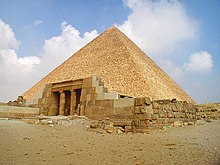Hectometre
Appearance
This article needs additional citations for verification. (April 2013) |
Look up hectometre in Wiktionary, the free dictionary.
The hectometre (International spelling as used by the International Bureau of Weights and Measures; SI symbol: hm) or hectometer (American spelling) is an uncommonly used unit of length in the metric system, equal to one hundred metres. It derives from the Greek word "ekato", meaning "hundred". A regulation football or soccer field is approximately 1 hectometre in length.
- For area the square hectometer (hm2) is a common unit. It is more commonly known by the name of hectare (ha), meaning 100 ares (100 a). The are is a measurement of area the size of 1 decametre by 1 decametre, which is 10 metres by 10 metres. Hence 100 ares equals an area with dimensions 100 m by 100 m — 1 hectometre by 1 hectometre, the square hectometre — equalling 10,000 square metres (10,000 m2)
- For volumes the cubic hectometre (hm3) is also used, 100 m by 100 m by 100 m equalling 1,000,000 cubic metres (1,000,000 m3).
- Conversion of units, for comparison with other units
Template:Orders of magnitude (length) imagemap human-scale


To compare different orders of magnitude this page lists lengths between 100 metres and 1000 metres (1 kilometre).
Distances shorter than 100 metres
Conversions
100 metres (sometimes termed a hectometre) is equal to:
- 328 feet
- one side of a 1 hectare square
- a fifth of a modern li, a Chinese unit of measurement
- the approximate distance travelled by light in 300 nanoseconds.
Human-defined scales and structures
- 100 metres — wavelength of the highest mediumwave radio frequency, 3 MHz
- 100 metres — spacing of driver location signs on British motorways.
- 138.8 metres — height of the Great Pyramid of Giza (Pyramid of Cheops)
- 139 metres — height of the world's tallest roller coaster, Kingda Ka[2]
- 187 metres— shortest wavelength of the broadcast radio AM band, 1600 kHz
- 202 metres — length of the Széchenyi Chain Bridge connecting Buda and Pest
- 320.75 metres — height of the Eiffel Tower(including antenna) [3]
- 328 metres — height of Auckland's Sky Tower (Auckland), the tallest free-standing structure in the Southern Hemisphere[when?]
- 341 metres — height of the world's tallest bridge, the Millau Viaduct[when?]
- 390 metres — height of the Empire State Building
- 400–800 metres — approximate heights of the world's tallest skyscrapers of the past 80 years.[when?]
- 458 metres — length of the Knock Nevis, the world's largest supertanker
- 555 metres — longest wavelength of the broadcast radio AM band, 540 kHz
- 630 metres — height of the KVLY-TV mast, second tallest structure in the world.
- 646 metres — height of the Warsaw radio mast, the world's tallest structure until its collapse in 1991.
- 828 metres — height of Burj Khalifa, world's tallest structure on 17 January 2009[4]
- 1000 metres — wavelength of the lowest mediumwave radio frequency, 300 kHz
Sports
- 100 metres — the distance a very fast human being can run in about 10 seconds
- 100.584 metres — length of a Canadian football field between the goal lines (110 yards)
- 91.5 metres – 137 metres — length of a soccer field[5]
- 105 metres — length of a typical football field
- 109.73 metres — total length of an American football field (120 yards, including the end zones)
- 110 – 150 metres the width of an Australian football field
- 135 – 185 metres the length of an Australian football field
- 137.16 metres — total length of a Canadian football field, including the end zones (150 yards)
Nature
- 115.5 metres — height of the world's tallest tree in 2007, the Hyperion sequoia[6]
- 310 metres — maximum depth of Lake Geneva
- 340 metres — distance sound travels in air at sea level in one second; see speed of sound
- 979 metres — height of the Salto Angel, the world's highest free-falling waterfall (Venezuela)
Astronomical
- 270 metres — length of 99942 Apophis, the smallest known asteroid
- 535 metres — length of 25143 Itokawa,[7] a small asteroid visited by a spacecraft
Distances longer than 1 kilometre
Notes
- ^ Highways Agency. "Driver Location Signs - Frequently Asked Questions". Retrieved 10 February 2010.
- ^ "Kingda Ka (Six Flags Great Adventure)". Archived from the original on 25 April 2009. Retrieved 18 April 2009.
{{cite web}}: Unknown parameter|deadurl=ignored (|url-status=suggested) (help) - ^ "Tour Eiffel". Retrieved 15 September 2010.
- ^ "Burj Dubai all set for 09/09/09 soft opening". Emirates Business 24-7. Archived from the original on 19 January 2009. Retrieved 17 January 2009.
{{cite news}}: Unknown parameter|deadurl=ignored (|url-status=suggested) (help) - ^ The Laws of The Game
- ^ http://www.monumentaltrees.com/en/trees/coastredwood/coastredwood/
- ^ Fujiwara, Akira; et al. (2 June 2006). "The Rubble-Pile Asteroid Itokawa as Observed by Hayabusa". Science. 312 (5778): 1330–1334. doi:10.1126/science.1125841. PMID 16741107. Archived from the original on 2 April 2009. Retrieved 20 April 2009.
{{cite journal}}: Unknown parameter|deadurl=ignored (|url-status=suggested) (help)
